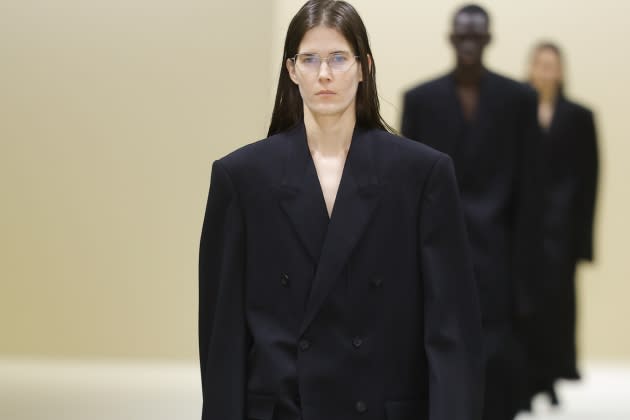Balenciaga RTW Fall 2023

Balenciaga’s fall show on Sunday morning, the first since its advertising scandal last November, felt different — very different.
Creative director Demna dispensed with celebrity hoopla and his dystopian sets — mud pit, wind tunnel, sunken stadium — to focus on “the art of making clothes,” which turned out to be his salvation when he and the house became engulfed in public outrage over ads that included children, sexualized teddy bears and papers related to a landmark child pornography case.
More from WWD
Zendaya and More at Louis Vuitton; Jessica Alba at Stella McCartney
Jessica Alba, Camila Alves Praise Stella McCartney's Sustainability Street Cred
The show Sunday at the ultimate old-school venue, the Carrousel du Louvre, went off without any noticeable hitch, the runway theater as plain as can be: rows of black chairs in a long room lined with white toile, the primary tool for tailoring and dressmaking. Retailers, editors, influencers and a smattering of VIPs filled the room, and WWD saw no sign of demonstrations outside like the ones witnessed in front of a few dozen Balenciaga stores in the U.S. last November and December.
(However, at the Akris show afterward, a man outside displayed placards in protest of Balenciaga.)
The brand has been largely silent since the controversy erupted, save for multiple apologies, promises to make major changes in its “content organization,” the funding of a three-year program with U.S.-based association National Children’s Alliance, and an expansive interview with a rueful Demna in Vogue.
During a preview at Balenciaga headquarters with WWD a few days before the show, Demna said his metier helped him weather the barrage of online hate and death threats that came in the wake of two campaigns: a holiday gift one featuring children posing alongside a variety of items, including stuffed animals dressed in bondage gear, and a celebrity-stacked spring fashion one which included a still life of a handbag resting on a page from the 2008 Supreme Court ruling “United States v. Williams,” which confirmed the promotion of child pornography as illegal and not protected by freedom of speech. (The image appeared only on Balenciaga’s e-store and was swiftly removed.)
“I kind of escaped or hid myself through work,” Demna related. “Especially in the most psychologically complicated moments where I needed to kind of survive it, I went home and started cutting and stitching.”
The Georgian designer said he grabbed a stash of vintage pants, and with his sewing machine and scissors set out to create new garments from them: Pants that turn into jackets, dresses or trenchcoats. “And this deconstruction literally became like a solution for me personally.”
He noted that the pant transformations, very reminiscent of Maison Margiela, where he worked earlier in his career, were the only elements in the fall collection created post-crisis. Famous for mapping out Balenciaga collections well in advance, he had initiated the fall ready-to-wear collection last October and claimed his plan all along was to open a new creative chapter, dialing down the bombast to focus more on the clothes.
A note placed on each seat read: “Fashion has become a kind of entertainment, but often that part overshadows the essence of it, which lays in shapes and volumes, silhouettes.”
The coed fall show unfurled in chapters: first the pants, then an exploration of biker clothes, followed by his fetish floral-print dresses, here pleated and with built-up, rounded shoulders, which were reprised for evening gowns, the closing look carpeted in wispy black feathers and belted with a bow.
Eliza Douglas opened the show with her usual impassive aura, but the models were less hurried, less angry, letting their bug-eyed sunglasses and extra-long sleeves telegraph the icy cool associated with the brand. They strolled to plaintive guitar strumming by Demna’s partner, Bfrnd, and there was no finale walk or runway bow.
Demna’s skill as a tailor and dressmaker shone through brightly in all three sections. The oversize tailoring built from pants was handsome, inventive and even wryly humorous, with left-open zippers serving as a vent on coats and jackets, and the pockets of leather jeans upside down at the bottom of blousons, unable to hold any cigarette lighter or house keys.
The motorcycle gear was shown with the inner airbags inflated, giving models a hunchback appearance, their skinny legs poking out of enormous padded boots. Warmup jackets with small logos were snug, but given the same rounded couture shoulders as all of Demna’s day dresses and gowns.
The loose dresses were lovely, and the eveningwear all worthy of Oscar night.
After the show, everyone rushed backstage as usual, but the scene was calmer: No Kim Kardashian wrapped in packing tape, and no television crews; only warm hugs and kisses on the cheek from Kering boss François-Henri Pinault and his mother Maryvonne, dressed in a beige coat crawling with jacquard Balenciaga logos.
During the preview, Demna confessed that he’d been asked by many people if he considered resigning, which he waved off as preposterous, given the number of people, more than 4,000, now employed by Balenciaga, and the glorious legacy of Cristóbal Balenciaga, the name more than a century old.
He also has been asked repeatedly if he would now make “boring clothes” to avoid another controversy. The answer was also a resounding no.
“I don’t want to become someone else,” he said. “Deep inside I think I’m a forever designer….Reconstructing through deconstruction is something that I’ve done since the beginning.”
He hinted that his next shows for Balenciaga will be even “more focused on the garments” as opposed to the immersive experiences of yore.
“I want people to see the work that we do for six months, and not the set design,” he said. “I cannot have it overshadow the collection because we make good clothes. I want people to see that and to focus on that.”
Launch Gallery: Balenciaga RTW Fall 2023
Best of WWD
